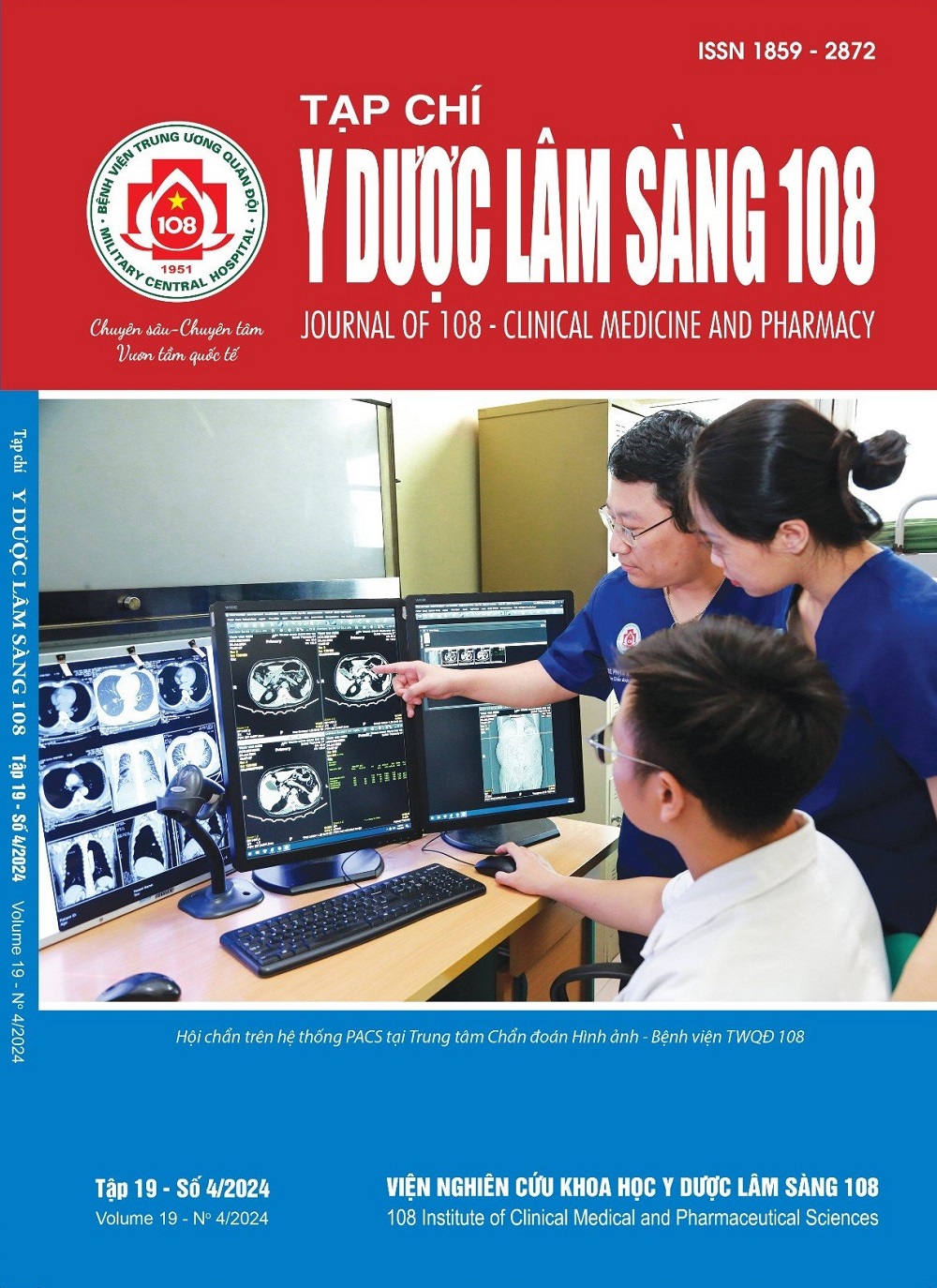Value of urinary L-FABP in predicting acute kidney injury in patients with sepsis and septic shock
Main Article Content
Keywords
Abstract
Objective: To evaluate the value of urinary L-FABP in predicting acute kidney injury in patients with sepsis and septic shock. Subject and method: A prospective observational study was conducted in 201 patients with sepsis and septic shock at 108 Military Central Hospital. Result: Urinary L-FABP concentration in the group with AKI was 56.97 ± 12.49µg/g Cre, higher than the non-AKI group (6.37 ± 3.61µg/g Cre), p<0.05. Urinary L-FABP concentration in the Septic shock group was 43.03 ± 10.57µg/g Cre higher than the Sepsis group (28.92 ± 9.94µg/g Cre), p<0.05. Urinary L-FABP at the time the patient was admitted to the Emergency Department had predictive value for AKI occurring on the 2nd and 3rd after admission, with AUC = 0.796 and AUC = 0.732, p<0.05. Conclusion: Urinary L-FABP concentration in the group with AKI was significantly higher than the group without AKI and using urinary L-FABP at the time of admission to the Emergency Department had a predictive value for AKI appearing on the 2nd and 3rd day after admission. The estimated sensitivity of urinary L-FABP for diagnosis of AKI was 87.7% and the specificity was 87.3% at the cut point of 12.26µg/g Cre.
Article Details
References
2. Hiruma T, Asada T, Yamamoto M, Inokuchi R, Matsubara T, Ishii T, Sumida M, Isshiki R, Mayumi K, Noiri E, Nangaku M, Yahagi N, Doi K (2014) Mortality prediction by acute kidney injury biomarkers in comparison with serum creatinine. Biomarkers 19(8): 646-451.
3. Coca SG, Nadkarni GN, Garg AX, Koyner J, Thiessen-Philbrook H, McArthur E, Shlipak MG, Parikh CR; TRIBE-AKI Consortium (2016) First post-operative urinary kidney injury biomarkers and association with the duration of AKI in the TRIBE-AKI cohort. PLoS One 11(8): 0161098.
4. Greenberg JH, Zappitelli M, and Jia Y (2018) Biomarkers of AKI progression after pediatric cardiac surgery. J Am Soc Nephrol 29(5):1549-1556. doi: 10.1681/ASN.2017090989.
5. Parikh CR, Puthumana J, Shlipak MG, Koyner JL, Thiessen-Philbrook H, McArthur E, Kerr K, Kavsak P, Whitlock RP, Garg AX, Coca SG (2017) Relationship of kidney injury biomarkers with long-term cardiovascular outcomes after cardiac surgery. J Am Soc Nephrol 28(12): 3699-3707.
6. Rhodes A (2017) Surviving sepsis campaign: International guidelines for management of sepsis and septic shock: 2016. Crit Care Med 45: 486-552.
7. KDIGO (2012) KDIGO clinical practice guideline for acute kidney injury. Kidney International Supplements, vol 2 supplement.
8. Negishi K, Noiri E, Doi K, Maeda-Mamiya R, Sugaya T, Portilla D, Fujita T (2009) Monitoring of urinary L-type fatty acid-binding protein predicts histological severity of acute kidney injury. Am J Pathol 174(4): 1154-1159.
9. Doi K, Noiri E, and Sugaya T (2010) Urinary L-type fatty acid-binding protein as a new renal biomarker in critical care. Curr Opin Crit Care 16(6): 545-549.
10. Nakamura T, Sugaya T, and Koide H (2009) Urinary liver-type fatty acid-binding protein in septic shock: effect of polymyxin B-immobilized fiber hemoperfusion. Shock 31(5): 454-459.
11. Ferguson MA, Vaidya VS, Waikar SS, Collings FB, Sunderland KE, Gioules CJ, Bonventre JV (2010) Urinary liver-type fatty acid-binding protein predicts adverse outcomes in acute kidney injury. Kidney Int 77(8): 708-714.
12. Cho E, Yang HN, Jo SK, Cho WY, Kim HK (2013) The role of urinary liver-type fatty acid-binding protein in critically ill patients. J Korean Med Sci 28(1): 100-105.
13. Yoshimatsu S, Sugaya T, Hossain MI, Islam MM, Chisti MJ, Kamoda T, Fukushima T, Wagatsuma Y, Sumazaki R, Ahmed T (2016) Urinary L-FABP as a mortality predictor in < 5-year-old children with sepsis in Bangladesh. Pediatr Int 58(3): 185-191.
14. Youness ER (2018) Urinary NGAL and L-FABP as valuable biomarkers for early detection of acute kidney injury in intensive care unit patients. ARC Journal of Nephrology 3(1): 19-28.
15. Suzuki G, Ichibayashi R, Yamamoto S, Nakamichi Y, Watanabe M, Honda M (2019) Clinical significance of urinary L-FABP in the emergency department. Int J Emerg Med 12(1): 24.
 ISSN: 1859 - 2872
ISSN: 1859 - 2872
